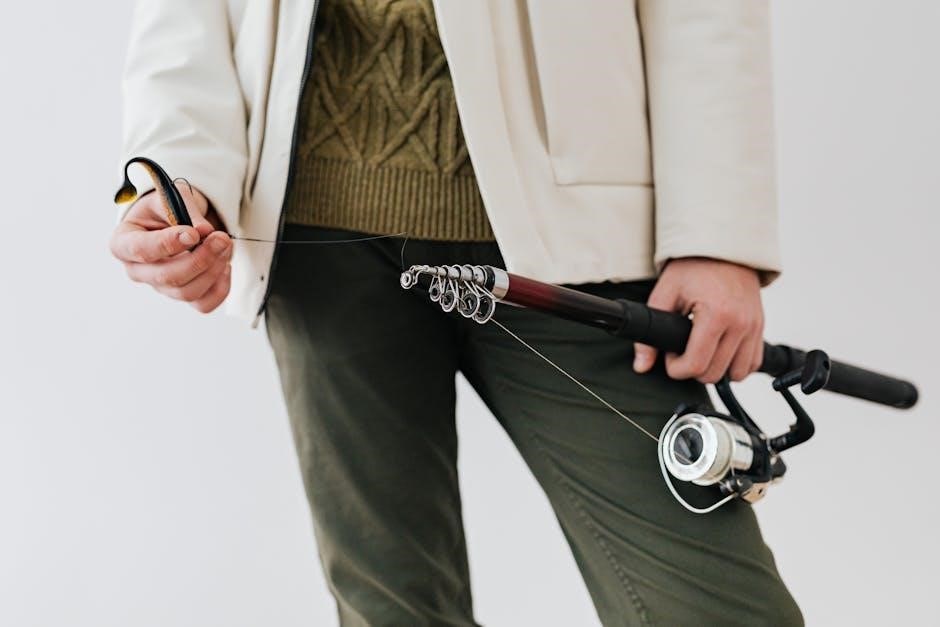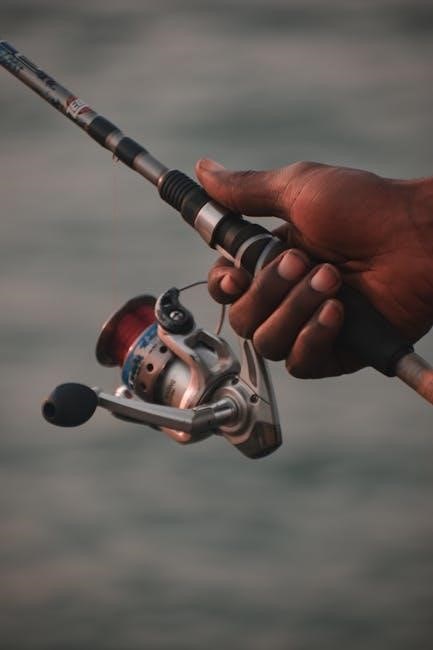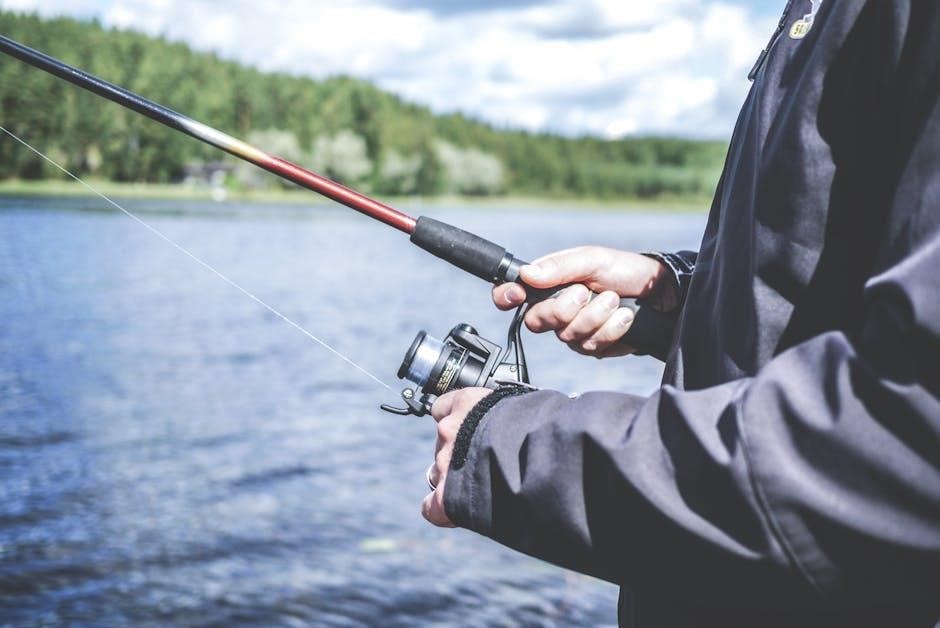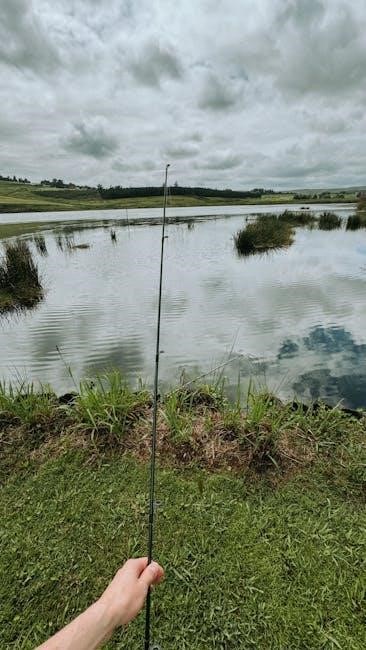Understanding Fishing Rod Length
Fishing rod length is crucial as it impacts casting distance, accuracy, and fish-fighting control. Longer rods excel in open waters for larger species, while shorter rods are ideal for tight spaces and precision casting.
How Rod Length Impacts Casting and Accuracy
Rod length significantly affects casting performance and precision. Longer rods (over 7 feet) provide greater leverage for distance casting and handling larger fish, while shorter rods (under 6 feet) offer better accuracy and control in tight spaces. Medium-length rods (6-7 feet) strike a balance, making them versatile for various fishing scenarios. The right length ensures optimal energy transfer during casting, improving both range and accuracy, and is essential for effectively targeting specific species and fishing conditions.
Rod Length and Target Species
Rod length is tailored to target species, as different fish sizes and strengths require specific gear; Longer rods (8-10 feet) are ideal for large species like marlin or tuna, offering greater leverage and casting distance. Medium-length rods (6-7 feet) are versatile for medium-sized fish like bass or trout. Shorter rods (5-6 feet) excel in catching smaller species in confined spaces. Matching rod length to the target species ensures effective control and success in various fishing environments.
Rod Length and Fishing Technique
Rod length significantly influences fishing technique, as it determines casting distance, accuracy, and control. Longer rods (8-10 feet) are ideal for surf fishing and casting lures over long distances. Shorter rods (5-6 feet) provide precise control, perfect for ice fishing or tight spaces. Medium-length rods (6-7 feet) balance versatility and maneuverability, suitable for spinning or baitcasting. Matching rod length to your fishing technique ensures optimal performance, whether you’re casting lures, using live bait, or fly fishing in various environments.
Fishing Rod Action Explained
Fishing rod action describes how a rod flexes under pressure, determining sensitivity and hook-setting power. It ranges from slow (full flex) to fast (tip flex), impacting technique and performance.
What is Rod Action and Why is it Important?
Rod action refers to how much a fishing rod bends when pressure is applied. It is crucial because it determines sensitivity, hook-setting power, and overall fishing performance. A slow action rod flexes more, providing greater sensitivity but less power, while a fast action rod flexes less, offering quick hook sets and better control. Choosing the right action depends on the fishing technique, target species, and personal preference.
Slow vs. Fast Action Rods
Slow action rods bend from the lower third, offering greater sensitivity and flexibility, ideal for techniques requiring finesse. Fast action rods bend near the tip, providing quick hook-setting power and control, suited for aggressive fishing styles. Slow action rods excel with live bait, while fast action rods are better for lures and jigging. The choice between them depends on fishing technique, target species, and personal preference, ensuring optimal performance in various angling scenarios.
Choosing the Right Action for Your Fishing Style
Matching rod action to your fishing style is key for optimal performance. Slow action rods suit finesse techniques and live bait, offering greater sensitivity. Fast action rods excel in aggressive styles, providing quick hook-setting power. Consider your target species, fishing method, and personal preference. For delicate presentations, slow action is ideal, while fast action rods are better for lures and active fishing. Balancing sensitivity and control ensures a tailored experience, enhancing your angling success and overall fishing enjoyment.

Fishing Rod Power and Line Weight
Fishing rod power determines the maximum line weight and species size it can handle effectively. Light to heavy power ratings ensure proper performance for specific fishing scenarios and techniques.
Understanding Rod Power Ratings
Fishing rod power ratings indicate the rod’s strength and ability to handle specific line weights and fish sizes. They range from ultralight to heavy, catering to different fishing scenarios. Light power rods are ideal for small species and delicate lures, while heavy power rods are designed for larger fish and demanding conditions. Matching the rod’s power to your target species ensures optimal performance, preventing damage to the rod and improving your chances of landing fish effectively.
Matching Line Weight to Rod Power
Matching line weight to rod power ensures optimal performance and prevents damage. Lighter rods require lighter lines for small species, while heavier rods demand stronger lines for larger fish. Check the rod’s power rating, usually indicated on the blank, to select the appropriate line weight. Mismatching can lead to poor casting, lost fish, or rod breakage. For example, a medium-heavy rod pairs well with a 10-15 lb line, balancing strength and sensitivity for versatile fishing scenarios.
Line Weight and Target Fish Size

Line weight is directly tied to the size of fish you target. Lighter lines (2-6 lb) are ideal for small species like trout or panfish, while heavier lines (15-30 lb) are suited for larger fish like bass or pike. Exceeding the rod’s line weight capacity can result in broken lines or damaged gear. Always match the line weight to the fish size you’re pursuing to ensure effective hook sets and successful landings. Proper balance enhances fishing efficiency and minimizes equipment failure.
Fishing Rod Materials and Durability
Fishing rods are made from graphite, fiberglass, or composite materials. Graphite offers sensitivity; fiberglass is durable; composites balance strength and flexibility, ensuring longevity and performance in various conditions.
Common Materials Used in Fishing Rods
Fishing rods are typically made from graphite, fiberglass, or composite materials. Graphite rods are lightweight and sensitive, ideal for detecting bites. Fiberglass rods are durable and flexible, often used for heavy-duty fishing. Composite rods combine graphite and fiberglass, offering a balance of strength and sensitivity. Each material suits different fishing styles and environments, ensuring anglers can choose the best option for their specific needs and target species.

Material Strength and Flexibility
Graphite rods offer exceptional strength and sensitivity, making them ideal for detecting subtle bites. Fiberglass rods provide durability and flexibility, absorbing the stress of larger fish. Composite materials blend graphite and fiberglass, balancing strength and flexibility for versatile performance. The choice of material depends on the fishing environment and target species, ensuring the rod can withstand the demands of the catch while maintaining responsiveness and control during casting and retrieval.
Durability and Maintenance Tips
Ensure your fishing rod’s longevity by cleaning it regularly with mild soap and water, avoiding harsh chemicals. Store rods in protective sleeves or cases to prevent scratches. Avoid exposing rods to extreme temperatures, as this can weaken the material. Handle rods gently to prevent bending or breaking. Inspect for wear, such as loose guides or cracks, and address issues promptly. Follow manufacturer guidelines for maintenance to preserve performance and extend lifespan;
Choosing the Right Rod Size for Different Fishing Environments

Choose rod size based on fishing environment. Freshwater fishing often uses 6-7 foot rods, while saltwater and surf fishing may require longer rods up to 12 feet. Ice fishing uses shorter rods for precision.
Freshwater vs. Saltwater Fishing Rods
Freshwater rods are lighter, shorter, and designed for smaller species like trout or bass, often using lighter lines and requiring precision. Saltwater rods are longer, sturdier, and built to handle larger fish in harsh marine environments, using heavier lines. Freshwater rods focus on accuracy, while saltwater rods emphasize strength and durability. The choice depends on the target species and fishing conditions, ensuring the right balance between performance and environmental demands.
Surf Fishing Rod Requirements

Surf fishing rods are typically longer (9-12 feet) to cast farther, with sturdy builds to handle large species like surf perch or striped bass. They often feature heavy power ratings for strength and durability in saltwater conditions. Look for rods made from corrosion-resistant materials like graphite or fiberglass, ensuring sensitivity and longevity. A medium to heavy action is ideal for managing strong currents and larger fish, while ergonomic designs improve comfort during extended casting sessions.
Ice Fishing Rod Considerations
Ice fishing rods are shorter (24-36 inches) for precision in tight spaces, with light to medium action for sensitivity to detect bites. Durable materials like graphite are ideal for cold conditions, offering strength and flexibility. Look for rods with ice-specific guides to prevent freezing and ensure smooth line flow. Pair with a reel suited for cold weather, using light line (2-8 lb) for panfish or slightly heavier for larger species. Compact designs enhance control and comfort during icy outings.

Additional Considerations for Selecting a Fishing Rod
Consider your budget, personal comfort, and local fishing regulations. Ensure the rod balances with your reel and line choice for optimal performance and fishing enjoyment.

Budget and Value for Money
Setting a budget is essential when selecting a fishing rod. High-quality rods can be an investment, but they offer durability and performance. Consider your fishing frequency and the species you target to balance cost and value. While premium rods boast advanced materials and craftsmanship, budget-friendly options can still deliver excellent results. Prioritize features that matter most to your fishing style, and compare prices to ensure you’re getting the best value for your money without compromising on quality or functionality.
Personal Preference and Ergonomics
Personal preference and ergonomics play a significant role in choosing a fishing rod. Consider the grip size, handle material, and overall weight to ensure comfort during long fishing trips. A rod that feels balanced in your hands can improve casting accuracy and reduce fatigue. Additionally, the handle length and shape should suit your fishing style, whether you prefer spinning, baitcasting, or fly fishing. Prioritizing ergonomics ensures a more enjoyable and effective fishing experience tailored to your needs and comfort level.
Local Fishing Regulations and Restrictions
Before selecting a fishing rod, it’s essential to check local fishing regulations. Many regions have specific rules about rod types, lengths, and allowable line weights. These restrictions often aim to conserve fish populations and ensure sustainable fishing practices. Failure to comply with local regulations can result in fines or penalties. Always verify the legal requirements for your fishing location to ensure your gear meets all specified standards and avoid any legal issues during your fishing trip.
Selecting the right fishing rod size is a balance of length, action, power, and personal preference. Consider your target species, fishing technique, and environment to make an informed choice. Always check local regulations to ensure compliance. By understanding these factors and matching them to your needs, you can enhance your fishing experience and improve your chances of success. Remember, the best rod is one that feels comfortable and suits your fishing style and budget.